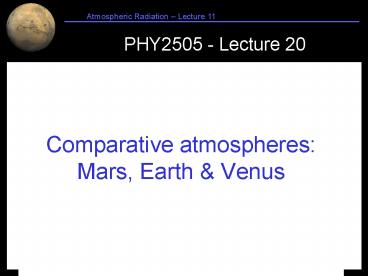PHY2505 Lecture 20 - PowerPoint PPT Presentation
1 / 19
Title:
PHY2505 Lecture 20
Description:
Comparative planetology is the name given to an approach to studying the planets. ... of an epoch of rapid plains emplacement by widespread, global volcanism? ... – PowerPoint PPT presentation
Number of Views:54
Avg rating:3.0/5.0
Title: PHY2505 Lecture 20
1
PHY2505 - Lecture 20
- Comparative atmospheres Mars, Earth Venus
2
Comparative planetology
Comparative planetology is the name given to an
approach to studying the planets. This approach
is based on the idea that the individual planets
can be better understood by comparing the
physical processes of all the planets. The basic
physical ideas in our physical models for one
planet must hold true in general for the other
planets. Comparing the atmospheres of planets,
particularly their thermal structures, gives us
insight into the processes that drive
climate. The terrestiral planets Venus, Earth
and Mars, formed at a similar time under similar
conditions and yet their climates vary
dramatically. A question is whether relatively
small changes to the thermal structure in the
Earths atmosphere could push it into the climate
regime of either of its nearest neighbours.
3
Effective temperature
http//solarsystem.colorado.edu/cu-astr/home/lowRe
s.html
4
Greenhouse hypotheses
- Primary atmospheres the region of the solar
nebula where terrestrial planets were formed was
too hot for the condensation of volatiles such as
CO2 or H2O. - These molecules either arrived
- as trace species, adsorbed on or captured in the
interiors of the solids that gradually accreted
to form the planets, or - they were brought in by comets, from the region
of the solar system beyond the snow line.
5
Water on planets
6
Greenhouse hypotheses
VENUS Temperature of Venus initially higher than
Earth Gases in atmosphere trap heat (greenhouse
effect) Any water on surface evaporates and adds
to greenhouse gases Subsequently water is broken
down and H escapes Temperature rises even more
Runaway greenhouse effect EARTH CO2 comparable
to Venus but adsorbed in surface by way of Urey
reactions MARS Gravity weaker than Earth,
secondary atmosphere sustained large losses
through atmospheric escape Reverse greenhouse
effect planet cold, water freezes reducing
greenhouse gases, freezes more, cools more
until low pressure below the triple point of water
7
Venus current atmosphere
Composition (near surface, by volume) CO2
96.5 N2 3.5 Minor species (ppm) SO2 - 150
Argon (Ar) - 70 Water (H2O) - 20 Carbon
Monoxide (CO) - 17 Helium (He) - 12 Neon (Ne)
- 7
8
Earth current atmosphere
Composition Nitrogen 78.08 Oxygen 20.95 Water
0 to 4 Argon 0.93 Carbon Dioxide 0.0360 Neon
0.0018 Helium 0.0005 Methane
0.00017 Hydrogen 0.00005 Nitrous Oxide
0.00003 Ozone 0.000004
9
Mars current atmosphere
Composition Carbon Dioxide (CO2) - 95.32
Nitrogen (N2) - 2.7 Argon (Ar) - 1.6 Oxygen
(O2) - 0.13 Carbon Monoxide (CO) - 0.08
Minor (ppm) Water (H2O) - 210 Nitrogen Oxide
(NO) - 100 Neon (Ne) - 2.5 Krypton (Kr) - 0.3
Xenon (Xe) - 0.08
10
State of current measurements
MARS
11
Climate problems Venus
Past climate Magellan mapping of surface
suggests recent geological activity whole
surface resurfaced 700M years ago has this
produced climate change? Current climate Is the
current climate stable? What governs formation of
H2SO4 clouds? Why are elevated winds so
high? Outgassing of SO2, CO2 reactions with
surface, - is Venus cooling?
12
Climate modelling Venus
Two-stream radiativeconvective model
high-resolution spectral databases
chemical/microphysical model of Venus clouds 1.
How do variations in atmospheric water and sulfur
dioxide affect cloud structure and planetary
albedo? How do these, in turn, affect the
temperature at the surface? 2. How does the
equilibration of atmospheric sulfur dioxide with
surface minerals affect cloud structure and
surface temper-ature, and over what
timescales? 3. How have changes in atmospheric
water abundance due to exospheric escape of
hydrogen and volcanic outgassing af-fected cloud
structure and surface temperature, and over what
timescales? 4. What was the effect on Venus
cloud structure and sur-facetemperature of an
epoch of rapid plains emplacement by widespread,
global volcanism?
13
Venus results
14
Venus results
15
Venus results
16
Climate problems Mars
Water faint young sun paradox definite
dramatic climate change 2Ga
17
Climate problems Mars
Global dust storms coupled feedbacks?
18
Climate problems Mars
Issues Past climate Producing enough CO2 to
sustain liquid water Currrent climate Asymmetry
of polar caps Feedback due to cloud and
dust Orbital cycle
19
Climate problems Mars































